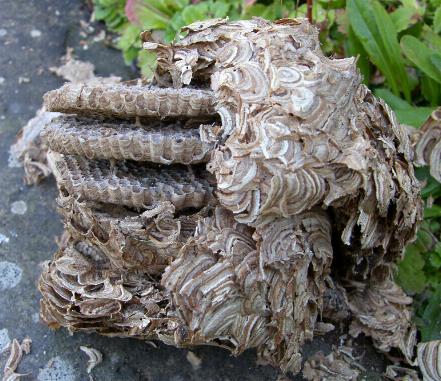An over-wintering 'queen' wasp which was found in some folded fabric in the potting shed.
There are over 30,000 different species of wasps, some are used in horticulture as biological controls. The best known is the Yellow and Black Wasp, Paravespula vulgaris which although feared by many, is also useful to the gardener, eating harmful flies and aphids as well as caterpillars. They have a 'sweet tooth', also eating nectar, refuse and fruit.
There are three distinct body divisions; the head with strong mandibles; the thorax with two pairs of transparent wings; and the abdomen which has the sting at the rear.
Wasp severing a caterpillar of the Small White Butterfly to take back to the nest.
Living in groups or colonies, they work together in three social types - the queen (a large female which starts the nest and lays eggs), workers (small females which build nests and feed the young), and drones (males). At the end of autumn, all of the wasps die except mated queens, which burrow into leaves or soil to spend the winter.
In the spring the queens emerge and start the nest building process. They are built underground, in buildings, in trees or in bushes. The wasps will prune small twigs to clear a flight-path through shrubs which is a clear indication that a nest is present. The nests are complex with many six-sided cells made from chewed wood and plant fibres which are mixed with saliva and dry to form a paper-like substance - it is said to have inspired the invention of paper. The gnawing to obtain raw material can cause superficial damage to wooden fences and buildings, it is often seen on dead branches or fence posts where the edges are smoothed off - the rasping noise of the mandibles can be heard if you are close enough to the process.
The pictures below were taken as a queen was starting a new nest attached to the ceiling of a wooden garage. The flash from the camera must have startled her and in the right hand picture she had moved up behind the first cells which revealed that she had already attached some eggs in some of them.

An old wasp nest showing the internal labyrinth.
Treatment
The wasps are more likely to be a nuisance in the autumn when they no longer have larvae to feed and go in search of ripe fruit and other sweet things. However they usually sting in response to a perceived attack which can be accidental if they become trapped in clothing or a nest is approached - button up clothing while picking fruit in the late summer to prevent a curious wasp crawling in while drowsy from eating a sugary meal. Also flapping wildly at their presence is likely to provoke a response so it is best to stay calm and move away slowly or wait until they fly away. However if you are close to a nest they will come straight for an attack and the first you may know about it is the strike. |
Back to GARDEN CREATURES, or use the floating menu above to find other garden-related topics. top/\